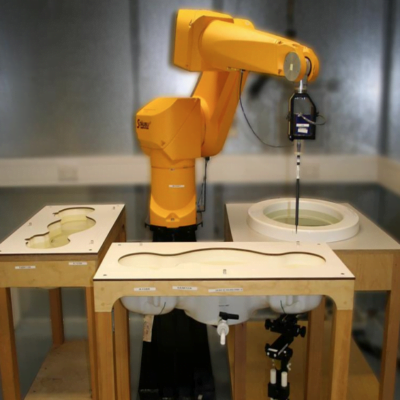Independent Testing Demonstrates That WaveWall Works
 Laboratory analysis shows 87% reduction in radiation exposure
Laboratory analysis shows 87% reduction in radiation exposure
We developed WaveWall by engineering three different prototypes, all based on the same concept but each employing a different technology. In September 2014 we subjected all three prototypes to a rigorous, independent SAR assessment by UL Verification Services Ltd, an accredited UK testing laboratory applying accepted international standards.
Our objective in running the tests was to see how successful the WaveWall concept would be at shielding a man’s testicles from mobile radiation. We also wanted to see which of our three prototypes would be the most effective.
Testing WaveWall’s ability to block radiation
A SAR test tells you how much electromagnetic radiation your body is being subjected to from your phone. The initials “SAR” stand for “specific absorption rate.” The lower the SAR number, the safer the result.
The UL Verification Services Ltd SAR test involved fixing a conventional Apple iPhone 5 exactly 5mm away from an electrical sensor that represents the user’s body. The laboratory then measured the amount of electromagnetic radiation that hit the sensor. This represents the amount of radiation that would be absorbed by a person carrying the phone in their pocket.
The first stage in the testing procedure was to carry out a control test with the iPhone on its own, to see how much radiation a person would absorb if the phone was used without protection. This gave a baseline figure against which to compare the results from our prototypes.
Next, the laboratory carried out scans with the phone placed into each of our three prototypes in turn, and measured how much radiation was allowed through to hit the sensor.
At the end of the test, the laboratory carried out a fifth scan, as a system check.
Effective protection from the radiation emitted by your phone
The test results showed that the best prototype, which was tested in Scan 3, (you can read the full test report by following the link below) reduced the SAR from 0.535 W/kg to 0.066 W/kg. In other words, our prototype cut the radiation absorbed by the body by 87%.
| Scan Number | SAR Result |
| Scan 1 – Control Scan | 0.535 W/kg |
| Scan 2 – WaveWall Variation 1 | 0.080 W/kg |
| Scan 3 – WaveWall Variation 2 | 0.066 W/kg |
| Scan 4 – WaveWall Variation 3 | 0.094 W/kg |
Because this prototype performed so well, it is the version we chose to manufacture and launch as WaveWall.
Based on these tests, WaveWall provides highly effective protection against the damage mobile radiation may cause to your testicles, thereby helping to protect both your sperm and your health.
Here is a link to the full UL testing report. The tests were performed on a development case (codenamed ‘Nutguard’) for our parent company, Lime Creations Ltd.
2017 SPORTON Testing
In 2017 we commissioned another test with an updated model of phone – an iPhone 6 – and for the WaveWall Flip case. Regular testing helps us keep up with changes in mobile phone models and new WaveWall designs, as well as changing technology.
Sporton Labs carried out a CE SAR test in accordance with the following standards:
- Council Recommendation 1999/519/EC
- EN 62311: 2008
- EN 50566:2013/AC:2014
- EN 62209-2:2010
Similar to the first testing, this test measured the Specific Absorption Rate (SAR) of an unprotected phone and a phone using the WaveWall Flip. The tests showed that the WaveWall Flip cut SAR by 83%.
83% reduction in SAR with the WaveWall Flip
| Scan | SAR Result |
| Control Scan | 1.360 W/kg |
| WaveWall Flip | 0.223 W/kg |
The report, which you can read here, describes the calculations for the SAR (Specific Absorption Rate), the setup for the experiment including the equipment, tissue verification, and test results.
The testing also included the Shield Your Body boxers. Download all the original SPORTON test data (ZIP file).
Airtubes Testing
Our Airtubes have also been rigorously tested. These headphones cut 99% of radiation from a mobile phone with their innovative wire-free design.
The Airtubes were tested versus traditional headphones, and no headphones being used. Five different phone modes were used: the phone on standby, the phone in use, the moment the phone is put through, an unanswered outgoing call, and an unanswered incoming mobile phone call.
The results here surpassed 99% reductions in the mobile phone radiation reaching the head. On page two you can see the tests of the Airtubes radiation-proof headphones versus a mobile phone, and on page three the tests for the Airtubes against standard headphones. At every point with an active mobile phone you can see huge reductions in the amount of radiation thanks to the Airtubes.
When viewing the test report you will notice that some information regarding the manufacturer of the Airtubes is redacted, for confidentiality purposes.
View the Airtubes Test Report (PDF).
